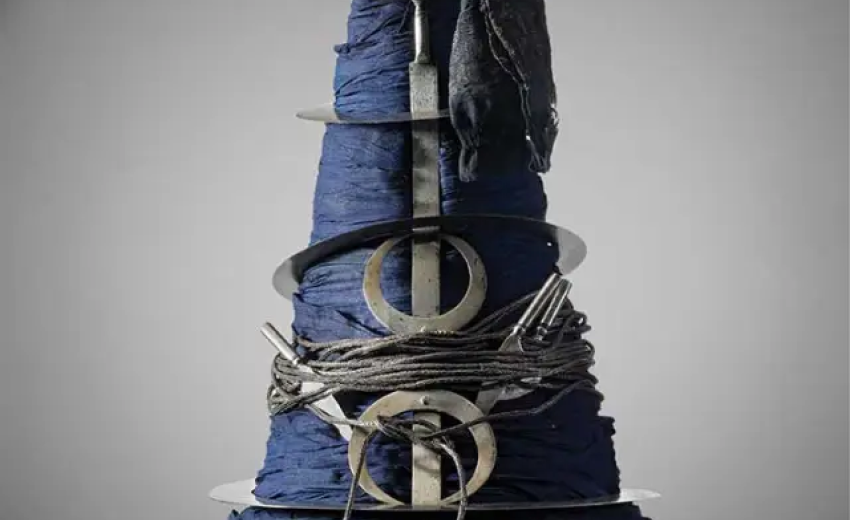Specifically, the Dastar Boonga, known as the turban fortress, embodies the Sikh warrior tradition.
In the British Museum, there is a Sikh fortress turban, a rare object of which only five exist in Britain. This particular one is wrapped around a wooden cone and was made for a ceremonial purpose rather than everyday wear.
Sikhism, a monotheistic faith established by Guru Nanak in AD 1469, upholds core principles including belief in a Universal god and the equality of all humanity. One iconic symbol deeply rooted in Sikh tradition is the turban, symbolising devotion to the faith and safeguarding the uncut hair, a sacred tenet.
Specifically, the Dastar Boonga, known as the turban fortress, embodies the Sikh warrior tradition. Its towering conical form resembles a fortress, offering significant protection during battles, shielding both hair and head from sword strikes. Tying this turban involves intricately intertwining long hair with cloth that can span up to 20 yards. Additionally, adornments like steel quoits and small daggers are often affixed, enhancing protection by winding plaited steel around the turban. This rich tradition not only honours Sikh heritage but also reflects the resilience and courage ingrained in Sikh identity.
The Dastaar Boonga
The Dastaar Boonga, a distinctive turban, has been and continues to be proudly worn by the Akali-Nihangs, a revered group within the Sikh community. Emerging during the period of religious persecution under the Mughal Empire in India (1526-1858), the Akali-Nihangs embody a rich martial tradition rooted in Sikh ethos. Initially raised by the sixth Sikh Guru, Guru Har Gobind, the Akalis, or Immortals, were entrusted with the noble task of safeguarding Sikhism against the tyranny of the Mughal regime.
Central to their identity is unwavering devotion to Akal, the timeless one, representing the Divine. The Akali-Nihangs epitomize the concept of the "Saint Soldier," blending spiritual wisdom with martial prowess to defend the oppressed and uphold Sikh values. Adorned in dark blue attire, iron bangles, steel quoits in their tall conical turbans, and armed with swords, daggers, and tiger claws, they symbolize resilience and strength. While their presence is most prominent in the Punjab region, the legacy of the Akali-Nihangs endures, preserving the original Sikh martial traditions and inspiring reverence for Sikh heritage and values.
The turban adorned with various ornaments, notably a modified Rattray Battalion badge, hints at potential associations with the British Army battalion established in January 1856 under Captain Thomas Rattray. This particular turban has been housed in the British Museum collection since the early twentieth century and was showcased at the Banqueting House, Westminster in 1900 as part of a 'Relics of Old Wars' exhibition.
Such turbans were sought after by British army generals during the late nineteenth century as examples of Indian art and culture. Evidently, they were custom-made for the British market, signifying a cross-cultural exchange and appreciation of Indian craftsmanship within the colonial context.
Fortress Turban at the British Museum
Distinctive to the original Sikh warriors of the Akali Nihangs, the formidable fortress turban – previously housed by the British Museum for nearly a century – boasts a towering, conical structure. Its towering conical shape closely resembles that of a fortress or tower, rendering it highly effective in combat by shielding both the hair and head from sword strikes.
The fabric can extend up to 20 yards, with ornate adornments including the Rattray Battalion badge, emblematic of the British Army squad under Captain Thomas Rattray during the 1856 Lahore campaign.
Over 150 years later, its exotic appeal remains undeniable, with army generals often bringing back these turbans as prized examples of Indian art and culture, sparking a surge in demand for replicas among collectors. Jessica Pinson, the Herbert’s Exhibitions Officer, expresses the curators’ sense of privilege in showcasing an artefact that symbolises both Sikh history and the social mosaic of the city. Additionally, a series of special events and discussions have been arranged to complement the exhibition.
*Based on an article compiled by SikhNet Team, published on 27th August 2013
